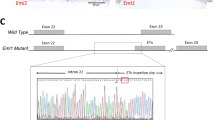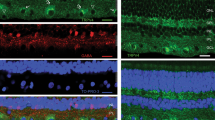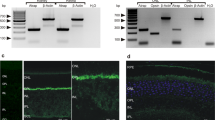Abstract
Cyclic-nucleotide-gated (CNG) channels in outer segments of vertebrate photoreceptors generate electrical signals in response to changes in cyclic GMP concentration during phototransduction1. CNG channels also allow the influx of Ca2+, which is essential for photoreceptor adaptation2. In cone photoreceptors, cGMP triggers an increase in membrane capacitance indicative of exocytosis, suggesting that CNG channels are also involved in synaptic function3. Here we examine whether CNG channels reside in cone terminals and whether they regulate neurotransmitter release, specifically in response to nitric oxide (NO), a retrograde transmitter that increases cGMP synthesis and potentiates synaptic transmission in the brain4,5,6. Using intact retina, we show that endogenous NO modulates synapses between cones and horizontal cells. In experiments on isolated cones, we show directly that CNG channels occur in clusters and are indirectly activated by S-nitrosocysteine (SNC), an NO donor. Furthermore, both SNC and pCPT–cGMP, a membrane-permeant analogue of cGMP, trigger the release of transmitter from the cone terminals. The NO-induced transmitter release is suppressed by guanylate cyclase inhibitors and prevented by direct activation of CNG channels, indicating that their activation is required for NO to elicit release. These results expand our view of CNG channel function to include the regulation of synaptic transmission and mediation of the presynaptic effects of NO.
This is a preview of subscription content, access via your institution
Access options
Subscribe to this journal
Receive 51 print issues and online access
$199.00 per year
only $3.90 per issue
Buy this article
- Purchase on Springer Link
- Instant access to full article PDF
Prices may be subject to local taxes which are calculated during checkout





Similar content being viewed by others
References
Yau, K.-W. & Baylor, D. A. Cyclic GMP-activated conductance of retinal photoreceptor cells. Annu. Rev. Neurosci. 12, 289–327 (1989).
Koutalos, Y. & Yau, K.-W. Regulation of sensitivity in vertebrate rod photoreceptors by calcium. Trends Neurosci. 19, 73–81 (1996).
Rieke, F. & Schwartz, E. A. AcGMP-gated current can control exocytosis at cone synapses. Neuron 13, 863–873 (1994).
Garthwaite, J., Charles, S. J. & Chess-Williaams, R. Endothelium-derived relaxing factor release on activation of NMDA receptors suggests role as intercellular messenger in the brain. Nature 336, 385–388 (1988).
O'Dell, T. J., Hawkins, R. D., Kandel, E. R. & Arancio, O. Tests of the roles of two diffusible substances in long-term potentiation: evidence for nitric oxide as a possible early retrograde messenger. Proc. Natl Acad. Sci. USA 88, 11285–11289 (1991).
Schuman, E. M. & Madison, D. V. Nitric oxide and synaptic function. Annu. Rev. Neurosci. 17, 153–183 (1994).
Maricq, A. V. & Korenbrot, J. I. Calcium and calcium-dependent chloride currents generate action potentials in solitary cone photoreceptors. Neuron 1, 503–515 (1988).
Wilkinson, M. F. & Barnes, S. The dihydropyridine-sensitive calcium channel subtypes in cone photoreceptors. J. Gen. Physiol. 107, 621–630 (1996).
Zimmerman, A. L., Yamanaka, G., Eckstein, F., Baylor, D. A. & Stryer, L. Interaction of hydrolysis-resistant analogs of cyclic GMP with the phosphodiesterase and light-sensitive channel of retinal rod outer segments. Proc. Natl Acad. Sci. USA 82, 8813–8817 (1985).
Watanabe, S.-I. & Matthews, G. Regional distribution of cGMP-activated ion channels in the plasma membrane of the rod photoreceptor. J. Neurosci. 8, 2334–2337 (1988).
Liepe, B. A., Stone, C., Koistinaho, J. & Copenhagen, D. R. Nitric oxide synthase in Muller cells and neurons of salamander and fish retina. J. Neurosci. 14, 7641–7654 (1994).
Kurenny, D. R. et al.Modulation of ion channels in rod photoreceptors by nitric oxide. Neuron 13, 315–324 (1995).
Koch, K. W., Lambrecht, H. G., Haberecht, M., Redburn, D. & Schmidt, H. H. Functional coupling of a Ca2+/calmodulin-dependent nitric oxide synthase and a soluble guanylyl cyclase in vertebrate photoreceptor cells. EMBO J. 13, 3312–3320 (1994).
Baylor, D. A., Fuortes, M. G. F. & O'Bryan, P. M. Receptive fields of single cones in the retina of the turtle. J. Physiol. (Lond.) 214, 265–294 (1971).
Piccolino, M., Neyton, J. & Gerschenfeldd, H. M. Centre-surround antagonism in small-field luminosity horizontal cells of turtle retina. J. Neurophysiol. 45, 363–375 (1981).
Wu, S. M. Synaptic transmission in the outer retina. Annu. Rev. Physiol. 56, 141–168 (1994).
Garthwaite, J. et al.Potent and selective inhibition of nitric oxide-sensitive guanylyl cyclase by 1H-[1,2,4]oxadiazolo[4,3-a]quinoxalin-1-one. Mol. Pharmacol. 48, 184–188 (1995).
Broillet, M.-C. & Firestein, S. Direct activation of the olfactory cyclic nucleotide-gated channel through modification of sulfhydryl groups by NO compounds. Neuron 16, 377–385 (1996).
Copenhagen, D. R. & Jahr, C. E. Release of endogenous excitatory amino acids from turtle photoreceptors. Nature 341, 536–539 (1989).
Tachibana, M. & Okada, T. Release of endogenous excitatory amino acids from ON-type bipolar cells isolated from the goldfish retina. J. Neurosci. 11, 2199–2208 (1991).
Mulsch, A., Busse, R., Liebau, S. & Forstermann, U. LY83583 interferes with the release of endothelium-derived relaxing factor and inhibits soluble guanylate cyclase. J. Pharmacol. Exp. Ther. 247, 282–288 (1988).
Barnes, S. & Hille, B. Ionic channels of the inner segment of tiger salamander cone photoreceptors. J. Gen. Physiol. 94, 719–743 (1989).
Normann, R. A. & Perlman, I. Signal transmission from red cones to horizontal cells in the turtle retina. J. Physiol. (Lond.) 286, 509–524 (1979).
Meffert, M. K., Premack, B. A. & Schulman, H. Nitric oxide stimulates Ca2+-independent synaptic vesicle release. Neuron 12, 1235–1244 (1994).
Arancio, O., Kandel, E. R. & Hawkins, R. D. Activity-dependent long-term enhancement of transmitter release by presynaptic 3′,5′-cyclic GMP in cultured hippocampal neurons. Nature 376, 74–80 (1995).
Kingston, P. A., Zufall, F. & Barnstable, C. J. Rat hippocampal neurons express genes for both rod retinal and olfactory cyclic nucleotide-gated channels: novel targets for cAMP/cGMP function. Proc. Natl Acad. Sci. USA 93, 10440–10445 (1996).
Bradley, J. et al.Functional expression of the heteromeric “olfactory” cyclic nucleotide-gated channel in the hippocampus: a potential effector of synaptic plasticity in brain neurons. J. Neurosci. 17, 1993–2005 (1997).
Finn, J. T., Grunwald, M. E. & Yau, K.-W. Cyclic nucleotide-gated ion channels: an extended family with diverse functions. Annu. Rev. Physiol. 58, 395–426 (1996).
Horn, R. Estimating the number of channels in patch recordings. Biophys. J. 60, 433–439 (1991).
Dixon, D. B. & Copenhagen, D. R. Metabotropic glutamate receptor-mediated suppression of an inward rectifier current is linked via a cGMP cascade. J. Neurosci. (1997) (in the press).
Barnes, S. & Deschenes, M. C. Contribution of Ca and Ca-activated Cl channels to regenerative depolarization and membrane bistability of cone photoreceptors. J. Neurophysiol. 68, 745–755 (1992).
Acknowledgements
We thank D. Eng for help with preliminary experiments; S. Nawy and R. Bookman for comments; and D. Dixon for advice on horizontal cell culture. This work was supported by grants from the NIH and the American Heart Association (R.H.K.), and the MRC Canada and the AHFMR (S.B.).
Author information
Authors and Affiliations
Corresponding author
Rights and permissions
About this article
Cite this article
Savchenko, A., Barnes, S. & Kramer, R. Cyclic-nucleotide-gated channels mediate synaptic feedback by nitric oxide. Nature 390, 694–698 (1997). https://doi.org/10.1038/37803
Received:
Accepted:
Published:
Issue Date:
DOI: https://doi.org/10.1038/37803
This article is cited by
-
Resolving the conflicts around Par2 opposing roles in regeneration by comparing immune-mediated and toxic-induced injuries
Inflammation and Regeneration (2022)
-
New perspectives in cyclic nucleotide-mediated functions in the CNS: the emerging role of cyclic nucleotide-gated (CNG) channels
Pflügers Archiv - European Journal of Physiology (2014)
-
Next-generation sequencing analysis of gene regulation in the rat model of retinopathy of prematurity
Documenta Ophthalmologica (2013)
-
Role of the synaptic ribbon in transmitting the cone light response
Nature Neuroscience (2009)
Comments
By submitting a comment you agree to abide by our Terms and Community Guidelines. If you find something abusive or that does not comply with our terms or guidelines please flag it as inappropriate.



